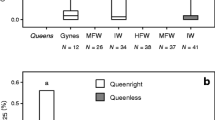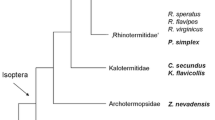Abstract
In ca. 150 species of queenless ants, a specialized queen caste is rare or absent, and mated workers take over the role of the queen in some or all of the colonies. Previously, it has been shown that reproduction in queenless ants is regulated by a combination of dominance behavior and chemical fertility signaling. It is unknown, however, whether chemical signals alone can sufficiently regulate reproduction. To investigate this possibility, we studied reproductive regulation in the facultatively queenless ant Gnamptogenys striatula, a species where dominance behavior is rare or absent. Active egg layers and infertile workers showed qualitative and quantitative differences in their cuticular hydrocarbon profile. Five long-chain methyl alkanes, 3,13- and 3,15-dimethyl pentriacontane, 3,13- and 3,15-dimethyl heptentriacontane, and 3,11,15-trimethyl heptentriacontane occurred only on the cuticles of virgin and mated egg layers. Pronounced quantitative differences were found in a further 27 alkenes; alkanes; and mono-, di-, and trimethyl alkanes. Workers that had recently stopped laying eggs had profiles similar to infertile workers, and mating status did not affect this chemical pattern. We conclude that the cuticular hydrocarbon profiles of G. striatula workers provide reliable information about their current fertility. In the interest of colony productivity, this allows reproduction to be regulated without the use of aggression.


Similar content being viewed by others
References
Billen, J. 1985. Ultrastructure of the worker ovarioles in Formica ants (Hymenoptera: Formicidae). Int. J. Insect Morphol. Embryol. 14:21–32.
Blatrix, R. and Jaisson, P. 2000. Optional gamergates in the queenright ponerine ant Gnamptogenys striatula Mayr. Insect. Soc. 47:1–5.
Blatrix, R. and Jaisson, P. 2001. Reproductive strategy of the ponerine ant Gnamptogenys striatula Mayr (Hymenoptera: Formicidae). Sociobiology 37:147–161.
Blomquist, G. J., Tillman, J. A., Reed, J. R., Gu, P., Vanderwel, D., Choi, S., and Reitz, R. C. 1995. Regulation of enzymatic activity involved in sex pheromone production in the housefly, Musca domestica. Insect Biochem. Mol. Biol. 25:751–757.
Blomquist, G. J., Tillman, J. A., Mpuru, S., and Seybold, S. J. 1998. The cuticle and cuticular hydrocarbons of insects: structure, function, and biochemistry, pp. 34–54, in R. K. Vandeer Meer, M. D. Breed, M. L. Winston, and K. E. Espelic (eds.). Pheromone communication in social insects: ants, wasps, bees, and termites. Oxford: Westview Press, Boulder.
Carlson, D. A., Bernier, U. R., and Sutton, B. D. 1998. Elution patterns form capillary GC for methyl-branched alkanes. J. Chem. Ecol. 24:1845–1865.
Cole, B. J. 1986. The social behavior of Leptothorax allardycei (Hymenoptera, Formicidae): Time budgets and the evolution of worker reproduction. Behav. Ecol. Sociobiol. 18:165–173.
Cuvillier-Hot, V., Cobb, M., Malosse, C., and Peeters, C. 2001. Sex, age and ovarian activity affect cuticular hydrocarbons in Diacamma ceylonense, a queenless ant. J. Insect Physiol. 47:485–493.
Cuvillier-Hot, V., Gadagkar, R., Peeters, C., and Cobb, M. 2002. Regulation of reproduction in a queenless ant: Aggression, pheromones and reduction in conflict. Proc. R. Soc. Lond. B. 269:1295–1300.
Cuvillier-Hot, V., Lenoir, A., Crewe, R., Malosse, C., and Peeters, C. 2004. Fertility signalling and reproductive skew in queenless ants. Anim. Behav. 68:1209–1219.
de Biseau, J.-C., Passera, L., Daloze, D., and Aron, S. 2004. Ovarian activity correlates with extreme changes in cuticular hydrocarbon profile in the highly polygynous ant, Linepithema humile. J. Insect Physiol. 50:585–593.
D'Ettorre, P., Heinze, J., Schulz, C., Francke, W., and Ayasse, M. 2004. Does she smell like a queen? Chemoreception of a cuticular hydrocarbon signal in the ant Pachycondyla inversa. J. Exp. Biol. 207:1085–1091.
Diehl, P. A. 1975. Synthesis and release of hydrocarbons by the oenocytes of the desert locust, Schistocerca gregaria. J. Insect Physiol. 21:1237–1246.
Dietemann, V., Peeters, C., Liebig, J., Thivet, V., and Hölldobler, B. 2003. Cuticular hydrocarbons mediate discrimination of reproductives and non-reproductives in the ant Myrmecia gulosa. Proc. Natl. Acad. Sci. U. S. A. 100:10341–10346.
Fan, Y., Zurec, L., Dykstra, M. J., and Schal, C. 2003. Hydrocarbon synthesis by enzymatically dissociated oenocytes of the abdominal integument of the German cockroach, Blattella germanica. Naturwissenschaften 90:121–126.
Fénéron, R. and Billen, J. 1996. Ovarian cycle in Ectatomma tuberculatum workers (Formicidae, Ponerinae). Invertebr. Reprod. Dev. 29:79–85.
Giraud, T., Blatrix, R., Poteaux, C., Solignac, M., and Jaisson, P. 2001. High genetic relatedness among nestmate queens in the polygynous ponerine ant Gnamptogenys striatula in Brazil. Behav. Ecol. Sociobiol. 49:128–134.
Gobin, B., Peeters, C., and Billen, J. 1998. Production of trophic eggs by virgin workers in the ponerine ant Gnamptogenys menadensis. Physiol. Entomol. 23:329–336.
Gobin, B., Billen, J., and Peeters, C. 2001. Dominance interactions regulate worker mating in the polygynous ponerine ant Gnamptogenys menadensis. Ethology 107:495–508.
Gobin, B., Heinze, J., Strätz, M., and Roces, F. 2003. The energetic cost of reproductive conflicts in the ant Pachycondyla obscuricornis. J. Insect Physiol. 49:747–752.
Heinze, J., Stengl, B., and Sledge, M. F. 2002. Worker rank, reproductive status and cuticular hydrocarbon signature in the ant, Pachycondyla cf. inversa. Behav. Ecol. Sociobiol. 52:59–65.
Ito, F. 1993. Functional monogyny and dominance hierarchy in the queenless ponerine ant Pachycondyla (= Bothroponera) sp. in West Java, Indonesia (Hymenoptera, Formicidae, Ponerinae). Ethology. 95:126–140.
Ito, F. and Higashi, S. 1991. A linear dominance hierarchy regulating reproduction and polyethism of the queenless ant Pachycondyla sublaevis. Naturwissenschaften 78:80–82.
Jensen, P. V. and Borgesen, L. W. 2000. Regional and functional differentiation in the fat body of pharaoh's ant queens, Monomorium pharaonis (L.). Arthropod Struct. Develop. 29:171–184.
Komene, Y., Higashi, S., Ito, F., and Miyata, H. 1999. Effect of colony size on the number of gamergates in the queenless ponerine ant Rhytidoponera aurata. Insect. Soc. 46:29–33.
Lattke, J. E. 1995. Revision of the ant genus Gnamptogenys in the New World (Hymenoptera: Formicidae). J. Hymenopt. Res. 4:137–193.
Liebig, J., Peeters, C., and Hölldobler, B. 1999. Worker policing limits the number of reproductives in a ponerine ant. Proc. R. Soc. London B. 266:1865–1870.
Liebig, J., Peeters, C., Oldham, N. J., Markstadter, C., and Hölldobler, B. 2000. Are variations in cuticular hydrocarbons of queens and workers a reliable signal of fertility in the ant Harpegnathos saltator? Proc. Natl. Acad. Sci. U.S.A. 97:4124–4131.
Monnin, T. and Peeters, C. 1999. Dominance hierarchy and reproductive conflicts among subordinates in a monogynous queenless ant. Behav. Ecol. 10:323–332.
Monnin, T. and Ratnieks, F. L. W. 1999. Reproduction versus work in queenless ants: When to join a hierarchy of hopeful reproductives? Behav. Ecol. Sociobiol. 46:413–422.
Monnin, T. and Ratnieks, F. L. W. 2001. Policing in queenless ponerine ants. Behav. Ecol. Sociobiol. 50:97–108.
Monnin, T., Malosse, C., and Peeters, C. 1998. Solid-phase microextraction and cuticular hydrocarbon differences related to reproductive activity in queenless ant Dinoponera quadriceps. J. Chem. Ecol. 24:473–490.
Peeters, C. 1991. The occurrence of sexual reproduction among ant workers. Biol. J. Linn. Soc. 44:141–152.
Peeters, C. 1993. Monogyny and polygyny in ponerine ants with or without queens, pp. 234–261, in L. Keller (ed.). Queen Number and Sociality in Insects. Oxford University Press, Oxford.
Peeters, C. and Crewe, R. 1984. Insemination controls the reproductive division of labour in a ponerine ant. Naturwissenschaften 71:50–51.
Peeters, C. and Crewe, R. 1985. Worker reproduction in the ponerine ant Ophthalmopone berthoudi: An alternative form of eusocial organization. Behav. Ecol. Sociobiol. 18:29–37.
Ratnieks, F. L. W., Foster, K. R., and Wenseleers, T. 2006. Conflict resolution in insect societies. Annu. Rev. Entomol. 51:581–608.
Sledge, M. F., Peeters, C. and Crewe, R. M. 2001. Reproductive division of labour without dominance interactions in the queenless ponerine ant Pachycondyla (=Ophthalmopone) berthoudi. Insect. Soc. 48:67–73.
Tay, W. T. and Crozier, R. H. 2000. Nestmate interactions and egg-laying behaviour in the queenless ponerine ant Rhytidoponera sp. 12. Insect. Soc. 47:133–140.
Tentschert, J., Kolmer, K., Hölldobler, B., Bestmann, H.-J., Delabie, J. H. C., and Heinze, J. 2001. Chemical profiles, division of labor and social status in Pachycondyla queens (Hymenoptera: Formicidae). Naturwissenschaften 88:175–178.
Tillman, J. A., Seybold, S. J., Jurenka, R. A., and Blomquist, G. J. 1999. Insect pheromones—an overview of biosynthesis and endocrine regulation. Insect Biochem. Mol. Biol. 29:481–514.
Tillman-Wall, J. A., Vanderwel, D., Kuenzli, M. E., Reitz, R. C., and Blomquist, G. J. 1992. Regulation of sex pheromone biosynthesis in the housefly, Musca domestica: Relative contribution of the elongation and reductive steps. Arch. Biochem. Biophys. 299:92–99.
Villet, M. 1991. Social differentiation and division of labour in the queenless ant Platythyrea schultzei Forel 1910 (Hymenoptera: Formicidae). Trop. Zool. 4:13–29.
Villet, M., Hart, A., and Crewe, R. 1990. Social organisation of Platythyrea lamellosa (Roger) (Hymenoptera: Formicidae) I. Reproduction. S. Afr. J. Zool. 25:250–253.
Ware, A. B., Compton, S. G., and Robertson, H. G. 1990. Gamergate reproduction in the ant Streblognathus aethiopicus Smith (Hymenoptera: Formicidae: Ponerinae). Insect. Soc. 37:189–199.
Wildman, M. H. and Crewe, R. M. 1988. Gamergate number and control over reproduction in Pachycondyla krugeri (Hymenoptera: Formicidae). Insect. Soc. 35:217–225.
Wilson, E. O. 1971. The Insect Societies. Harvard University Press, Cambridge, MA.
Acknowledgments
We are grateful to T. Lauwers for ant care and K. Collart for technical assistance. The Ministry of Environment and Energy granted permission to collect the ants in Costa Rica (resolution no. 131-2002-OFAU and 282-2003-OFAU). We also thank the Research Council of the University of Leuven (research project 01.24), the Fund for Scientific Research-Flanders (Belgium, research project G.0247.02), and the European Community's Improving Human Potential Programme (contract HPRN-CT-2000-00052 “INSECTS”) for financial support. This study complies with Belgian and Costa Rican law.
Author information
Authors and Affiliations
Corresponding author
Rights and permissions
About this article
Cite this article
Lommelen, E., Johnson, C.A., Drijfhout, F.P. et al. Cuticular Hydrocarbons Provide Reliable Cues of Fertility in the Ant Gnamptogenys striatula . J Chem Ecol 32, 2023–2034 (2006). https://doi.org/10.1007/s10886-006-9126-8
Received:
Revised:
Accepted:
Published:
Issue Date:
DOI: https://doi.org/10.1007/s10886-006-9126-8




